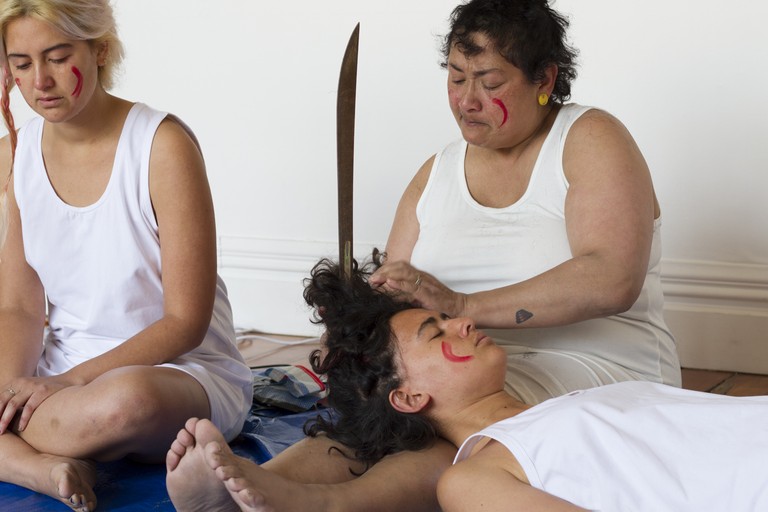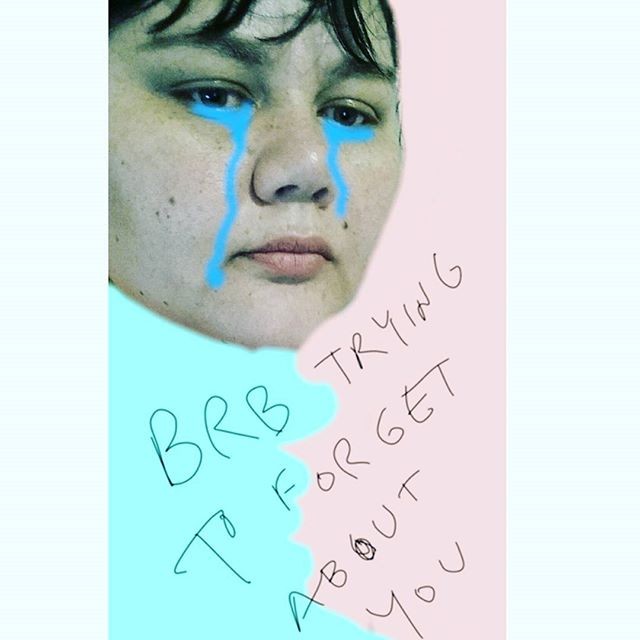The Occasional Journal
To find a place
April 2018
-
Editorial
Louise Rutledge -
Free arguments: [Under construction]
Layne Waerea -
Pointing out event-lets
Victoria Wynne-Jones -
Radical Silence in Performance Art: Kalisolaite ‘Uhila’s Maumau-taimi’
Chris Braddock -
I instagram myself to sleep, 2016–2017
Sione Monu -
Waiting for love in library aisles
Natasha Matila-Smith -
Who’s missing and how can we reach them?
Dilohana Lekamge
Editorial
Louise Rutledge
On Saturday November 14, 2015, Leafa Wilson/Olga Krause sat cross-legged on the floor of Enjoy Public Art Gallery, flanked by her daughters Faith and Olive Wilson. Shrouded with a blue tarpaulin, Krause remained still as the two women uncovered her and shaved her head. The sisters, after plaiting a small section of each other’s hair, each lay down upon Krause’s lap as she hacked away dramatic lengths of her daughters’ hair with a sapelu (machete). One by one, onlookers were invited to come forward to cut away a lock of hair for themselves, to carry it until it could be buried in the ground as an act of regeneration.
As an emotional, violent and mediated act, the collective performance sought to disrupt the political and personal bonds that weave through the three women: long hair and beauty, mother and daughter, femininity and domesticity. Titled Fili, the Samoan term for thread, the work laid bare their personal histories and the strength of their matrilineal gafa (genealogies), while acknowledging the productive potential of anger. As the performance developed, the women and those in the audience were brought to tears by the strength of these actions. In seeking separation from their maternal and daughter roles, the women acknowledged each other equally as women and as participants. Rejecting the oppressive patriarchal standards that limit women’s emotional states and enforces predominantly Western standardised beauty ideals, the performance, most pertinently, professed that the Polynesian female body is a site of empowerment, beauty and independence.1
Encountering this performance within the white walls of the gallery, its meanings were first produced from the initial site of impact—the body, its subjectivities and the relationships that connect one to another. Yet, these are not held in isolation, nor are such ideas relative to the body alone. Working within an established gallery space, these actions can be seen as responsive to the structural inequalities of the site, and a reflection on whose bodies are privileged and given space within such institutions.2 This was not the only site the performance occupied, as a video of the performance was installed in the gallery in the week following and the hair—collected by both the audience and then the family—made its way offsite and back into the ground. In each space, the experience shifted.

Faith, Leafa and Olive Wilson, Fili, 2015, performance, Enjoy Public Art Gallery. Image courtesy of Harry Culy.
For the sixth edition of the Enjoy Occasional Journal, the following collection of articles, responses and page works focus on the spaces in which performances are enacted, documented and brought into contact with audiences. From this perspective, the sites of encounter and dissemination for a selection of performance-based work within Aotearoa and further afield are considered. This is an inquiry into where the body has agency, in which spaces it can move, enact and be questioned—where the conditions of surveillance and documentation that characterise how we move through the world can be considered as subversive and generative tools.
To find a place acknowledges “place” or “site,” not as autonomous spaces, but as areas where social/societal norms, the law and technology intersect. This perspective is explored most openly by artist Layne Waerea, whose work features as the cover for this edition of the Occasional Journal. Exploring the boundaries of what is both considered socially acceptable and legally permissible within public spaces, Waerea’s interventions first appear as modest, humorous actions. Combining documents and first-hand accounts in response to a specific law and/or event, these interventions speak to an understanding of space not simply as a physical or public site, but as a location where the political and legal intersects. Acknowledging the Treaty of Waitangi (1840) as one of the governing frameworks within Aotearoa, Waerea’s practice questions land-use and ownership and comments on the unseen structures that form part of our political environment.
It is the considered simplicity of gestures such as Waerea’s that Victoria Wynne-Jones’ article “Pointing out event-lets” recognises the strength in, focusing on interpersonal relations and the intimate moments of encounter to which performance lends itself. In response to a series of questions presented to artists Audrey Baldwin, Alicia Frankovich, Mark Harvey, Robyn Jordaan, and Angela Tiatia, the possibilities for performance to enact change are discussed. Weaving together perspectives from these artists, Wynne-Jones’s discussion focuses on “the delicateness of the event,” tracing the impact of the artists’ gestures through events that put the body on display and on-site. Through the use of references from theatre, dance and critical theory, the fluidity of how performance is defined is challenged through the varied sources.
From small moments to quiet moments, Chris Braddock’s article looks at the work of Kalisolaite ‘Uhila through the lens of radical silence, advocating that non-active or non-vocal ways of working can create a different understanding of what it means to listen and be attentive. While recognising the potential framework silence can create to encounter another, this dialogue is challenged upon encountering the passivity of ‘Uhila’s work, as his silence cannot be separated from his own subjectivity and the experience and perceptions of Pacific Islanders within Aotearoa. Discussing ‘Uhila’s work further, Dilohana Lekamge’s essay “Who’s missing and how can we reach them?” uses Uhila’s performance Maumau-taimi as an example of how different cultures can be represented in galleries. Highlighting the potential for performance art to both represent and connect with Indigenous, minority, or POC artists, Lekamge frames performance as political act—one that insert the body into spaces as a form of self-representation and self-determination.
It is these experiences and perceptions that inform the work of multi-disciplinary artist Sione Monu, who exhibited at Enjoy in 2017 as part of the collective WITCHBITCH, a sub-collective formed with fellow FAFSWAG members Pati Solomona Tyrell and Manu Vea. For their exhibition Statuesque Anarchy, the trio activated the gallery with their moving image and performance pieces to reclaim the space within the Vā—the contextual and metaphysical space that exists between all things—and re-write queer Polynesian spiritual experiences. As fellow artist Manu Vea wrote, another “major component of Sione’s practice is his Instagram profile (@sione93) which currently has 1400+ followers and is his primary platform for the candid documentation of his personal life and the art created.”3 Scrolling through the platform, Monu’s videos document everyday moments and romantic endeavours. Carefully edited and framed, the videos can be read both within the context of self-expression on social media, and within the context of performative practice. Connecting both to other artists and people living in diaspora through social media, Monu’s videos exercise control over their image and an awareness of how that image is constructed. Among the hordes of exhaustive and mundane imagery, this awareness offers a moment of viewing that is reflexive, critical and engaging. By watching, either on phones or in the following pages, we become viewers in a space that is not separated from lived social experiences, but presents them as a form of self-surveillance.
Bringing together online imagery and confessional text, Natasha Matila-Smith continues her on-going exploration of the language and social complexities of romance. While the artwork Matila-Smith produces is not what we might associate with performance art, Matila-Smith works from a perspective that is embodied and relational, recognising that “the field covered by performance has… been expanded and blurred by growing discussions on performativity and its implications for language and power within broader areas of artistic and social practice.” Filtering through social media and exhibition spaces, Matila-Smith’s honest admissions address longing, desire and social anxieties from a perspective that is at times as universal as it is deeply personal. Incorporating images already disseminated via on-line platforms, Matila-Smith’s work further speaks to the impact of technology’s integration into everyday life as “the pernicious effects of global capitalism have led to a subsumption of not only labour, but also the self, the body and social life into its process.”5 Here, the works’ dual-existence in online spaces speaks to the fluidity of digital artworks and the collapse in distinctions between work and non-work as social gestures become a form of capital (whether monetary, social or artistic).

Natasha-Matila Smith, 2017. Image courtsey of the artist.
Performance has always had a place within Enjoy’s programming. Search the term on this website and 141 events, published responses and performances series are brought forth from the archive. From live events to recorded acts, this small survey of practice in Aotearoa reveals an expansive range of concerns and a history of reflecting back through images, publications and articles. This cache of information surveys both the interdisciplinary nature of performance and the different ways its documents are formed. These documents, produced by and in response to artists, can only ever represent part of any one experience, but their stillness offers the opportunity to reflect on them further. It is with this sentiment in mind that this journal has been produced. By creating a place for performance to be considered beyond the temporal event, we can, as Wynne-Jones summarises, pay attention “to something even smaller, the event-lets or little units or moments within”. As such, the following writing, pageworks and articles present only a small snapshot of artistic practice, but one that begins to unravel the relational, embodied and discursive forms that performance offers.
-
1.
Olga Krause, Faith Wilson and Olive Wilson, Fili, 2015, http://enjoy.org.nz/events/fili. For further discussion on the bodies of Polynesian women in contemporary performance, see Lana Lopesi and Louisa Afoa’s essay “Body Language” at http://enjoy.org.nz/publishing/the-occasional-journal/love-feminisms/body-language#article
-
2.
In reference to Leafa Wilson and Olga Krause’s performance and installation Unprotected #1: This ain’t no disco at ST PAUL St Gallery in Auckland in 2016, curators Abby Cunnane and Charlotte Huddleston stated that “Wilson & Krause’s work often takes place in institutional spaces, and in this sense is directly responsive to the structural inequities that often exist there, and to the need as artists and curators to find habitable positions ‘within’ such institutional systems.” For the full exhibition text, see https://stpaulst.aut.ac.nz/all-exhibitions/still,-like-air,-ill-rise
-
3.
Manu Vea, “sione monū: Creative magnetism”, Tautai Newsletter (September 2017): 1–2, https://issuu.com/tautaipacificartstrust/docs/tautai_news_sept_2017_web
-
4.
Is the Living Body the Last Thing Left Alive?: The New Performance Turn, its Histories and its Institutions, e-flux, January 16, 2018, http://www.e-flux.com/announcements/169228/is-the-living-body-the-last-thing-left-alive-the-new-performance-turn-its-histories-and-its-institutions/
-
5.
Audrey Schmidt, Chloe Sugden and Zoe Theodore, “Editorial”, ed. Audrey Schmidt, Chloe Sugden and Zoe Theodore, Dissect 3 (Melbourne: Dissect Journal, 2016): 30–33.
